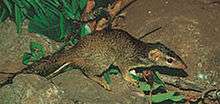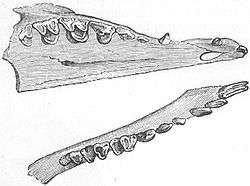Treeshrew
| Treeshrews[1] Temporal range: ?Middle Eocene – Recent | |
|---|---|
 | |
| Madras treeshrew (Anathana ellioti) | |
| Scientific classification | |
| Kingdom: | Animalia |
| Phylum: | Chordata |
| Class: | Mammalia |
| Infraclass: | Eutheria |
| Superorder: | Euarchontoglires |
| Order: | Scandentia Wagner, 1855 |
| Families | |
The treeshrews (or tree shrews or banxrings[2]) are small mammals native to the tropical forests of Southeast Asia. They make up the families Tupaiidae, the treeshrews, and Ptilocercidae, the pen-tailed treeshrew, and the entire order Scandentia. The 20 species are placed in five genera. Treeshrews have a higher brain to body mass ratio than any other mammals, including humans,[3] but high ratios are not uncommon for animals weighing less than a kilogram.
Though called 'treeshrews', and despite having previously been classified in Insectivora, they are not true shrews, and not all species live in trees. Among other things, treeshrews eat Rafflesia fruit.
Among orders of mammals, treeshrews are closely related to primates, and have been used as an alternative to primates in experimental studies of myopia, psychosocial stress, and hepatitis.[4]
Characteristics
Treeshrews are slender animals with long tails and soft, greyish to reddish-brown fur. The terrestrial species tend to be larger than the arboreal forms, and to have larger claws, which they use for digging up insect prey. They are omnivorous, feeding on insects, small vertebrates, fruit, and seeds. They have poorly developed canine teeth and unspecialised molars, with an overall dental formula of: 2.1.3.33.1.3.3[5]
Treeshrews have good vision, which is binocular in the case of the more arboreal species. Most are diurnal, although the pen-tailed treeshrew is nocturnal.
Female treeshrews have a gestation period of 45 to 50 days and give birth to up to three young in nests lined with dry leaves inside tree hollows. The young are born blind and hairless, but are able to leave the nest after about a month. During this period, the mother provides relatively little maternal care, visiting her young only for a few minutes every other day to suckle them. Treeshrews reach sexual maturity after around four months, and breed for much of the year, with no clear breeding season in most species.[5]
These animals live in small family groups, which defend their territory from intruders. They mark their territories using various scent glands, or urine, depending on the particular species.
The name Tupaia is derived from tupai, the Malay word for squirrel,[6] and was provided by Sir Stamford Raffles.[7]
The pen-tailed treeshrew in Malaysia is able to consume large amounts of naturally fermented nectar up to 3.8% alcohol content the entire year without having any effects on behaviour.[8]
Classification

Treeshrews were moved from Insectivora to the Primates order because of certain internal similarities to the latter (for example, similarities in the brain anatomy, highlighted by Sir Wilfred Le Gros Clark), and classified as a "primitive prosimian". However, molecular phylogenetic studies have strongly suggested the treeshrews should be given the same rank (order) as the primates and, with the primates and the flying lemurs (colugos), belong to the clade Euarchonta. According to this classification, the Euarchonta are sister to the Glires (lagomorphs and rodents), and the two groups are combined into the clade Euarchontoglires.[9] Other arrangements of these orders were proposed in the past.[10]
| Euarchontoglires |
| ||||||||||||||||||||||||||||||
| |
- ORDER SCANDENTIA
- Family Tupaiidae
- Genus Anathana
- Madras treeshrew, A. ellioti
- Genus Dendrogale
- Bornean smooth-tailed treeshrew, D. melanura
- Northern smooth-tailed treeshrew, D. murina
- Genus Tupaia
- Northern treeshrew, T. belangeri
- Golden-bellied treeshrew, T. chrysogaster
- Striped treeshrew, T. dorsalis
- Common treeshrew, T. glis
- Slender treeshrew, T. gracilis
- Horsfield's treeshrew, T. javanica
- Long-footed treeshrew, T. longipes
- Pygmy treeshrew, T. minor
- Calamian treeshrew, T. moellendorffi
- Mountain treeshrew, T. montana
- Nicobar treeshrew, T. nicobarica
- Palawan treeshrew, T. palawanensis
- Painted treeshrew, T. picta
- Ruddy treeshrew, T. splendidula
- Large treeshrew, T. tana
- Genus Urogale
- Mindanao treeshrew, U. everetti
- Genus Anathana
- Family Ptilocercidae
- Genus Ptilocercus
- Pen-tailed treeshrew, P. lowii
- Genus Ptilocercus
- Family Tupaiidae
Fossil record
The fossil record of treeshrews is poor. The oldest putative treeshrew, Eodendrogale parva, is from the Middle Eocene of Henan, China, but the identity of this animal is uncertain. Other fossils have come from the Miocene of Thailand, Pakistan, India, and Yunnan, China, as well as the Pliocene of India. Most belong to the family Tupaiidae, but some still-undescribed fossils from Yunnan are thought to be closer to the pen-tailed treeshrew. Named fossil species include Prodendrogale yunnanica, Prodendrogale engesseri, and Tupaia storchi from Yunnan, Tupaia miocenica from Thailand, and Palaeotupaia sivalicus from India.[11]
References
- ↑ Helgen, K.M. (2005). Wilson, D.E.; Reeder, D.M., eds. Mammal Species of the World: A Taxonomic and Geographic Reference (3rd ed.). Johns Hopkins University Press. pp. 104–109. ISBN 978-0-8018-8221-0. OCLC 62265494.
- ↑
 Rines, George Edwin, ed. (1920). "Tree-shrew". Encyclopedia Americana.
Rines, George Edwin, ed. (1920). "Tree-shrew". Encyclopedia Americana. - ↑ "Tupaia belangeri". The Genome Institute, Washington University. Retrieved January 2012. Check date values in:
|access-date=(help) - ↑ Cao, J; Yang, E-B; Su, J-J; Li, Y; Chow P (2003). "The tree shrews: adjuncts and alternatives to primates as models for biomedical research" (PDF). J Med Primatol. 32: 123–130. Retrieved January 2012. Check date values in:
|access-date=(help) - 1 2 Martin, Robert D. (1984). Macdonald, D., ed. The Encyclopedia of Mammals. New York: Facts on File. pp. 440–445. ISBN 0-87196-871-1.
- ↑ Nowak, R. M. (1999). Walker's Mammals of the World. Johns Hopkins University. p. 245. ISBN 0-8018-5789-9.
- ↑ Craig, John (1849). A new universal etymological technological, and pronouncing dictionary of the English Language.
- ↑ Moscowicz, Clara. 2008. Tiny tree shrew can drink you under the table.
- ↑ Janecka, Jan E.; Miller, Webb; Pringle, Thomas H.; Wiens, Frank; Zitzmann, Annette; Helgen, Kristofer M.; Springer, Mark S.; Murphy, William J. (2007-11-02). "Molecular and Genomic Data Identify The Closest Living Relatives of Primates" (PDF). Science. 318 (5851): 792–4. Bibcode:2007Sci...318..792J. doi:10.1126/science.1147555. PMID 17975064.
- ↑ Pettigrew JD, Jamieson BG, Robson SK, Hall LS, McAnally KI, Cooper HM (1989). "Phylogenetic relations between microbats, megabats and primates (Mammalia: Chiroptera and Primates)". Philosophical Transactions of the Royal Society B. 325 (1229): 489–559. Bibcode:1989RSPTB.325..489P. doi:10.1098/rstb.1989.0102.
- ↑ Ni, X.; Qiu, Z. (2012). "Tupaiine tree shrews (Scandentia, Mammalia) from the Yuanmou Lufengpithecus locality of Yunnan, China". Swiss Journal of Palaeontology. 131: 51–60. doi:10.1007/s13358-011-0029-0.